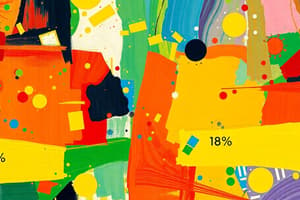Podcast
Questions and Answers
माइक्रोइकोनॉमिक्स से संबंधित कौनसा विषय है?
माइक्रोइकोनॉमिक्स से संबंधित कौनसा विषय है?
- मूल्य और मात्रा (correct)
- मार्केट संरचना
- मजबूती की खपत
- जीडीपी वृद्धि दर
मास्टर कार्ड से संबंधित कौन-कौन से विषय माइक्रोइकोनॉमिक्स से संबंधित हैं?
मास्टर कार्ड से संबंधित कौन-कौन से विषय माइक्रोइकोनॉमिक्स से संबंधित हैं?
- मार्केट संरचना
- मूल्य पेशकश
- लेबर कॉस्ट्स (correct)
- प्रोडक्शन कॉस्ट
माक्रोइकोनॉमिक्स विचार में कौनसा प्रमुख तत्व नहीं शामिल है?
माक्रोइकोनॉमिक्स विचार में कौनसा प्रमुख तत्व नहीं शामिल है?
- मुद्रास्फीति स्तर
- राजनीतिक संरचना (correct)
- कुल घरेलू उत्पाद
- लाभ
मार्केट संरचना में किस प्रकार का प्रमुख संकेत होता है?
मार्केट संरचना में किस प्रकार का प्रमुख संकेत होता है?
अंतर्राष्ट्रीय व्यापार से संबंधित कौन-कौन से पहलु छुपे होते हैं?
अंतर्राष्ट्रीय व्यापार से संबंधित कौन-कौन से पहलु छुपे होते हैं?
अर्थशास्त्र का मुख्य उद्देश्य क्या है?
अर्थशास्त्र का मुख्य उद्देश्य क्या है?
किसका लक्ष्य है 'रोजगार के अवसरों को बढ़ाना'?
किसका लक्ष्य है 'रोजगार के अवसरों को बढ़ाना'?
महत्वपूर्ण अंतरराष्ट्रीय व्यापार मुद्रा के साथ संबंधित किस प्रक्रिया पर आधारित है?
महत्वपूर्ण अंतरराष्ट्रीय व्यापार मुद्रा के साथ संबंधित किस प्रक्रिया पर आधारित है?
'मिश्रित अर्थकला' में कौन-कौन से घटक होते हैं?
'मिश्रित अर्थकला' में कौन-कौन से घटक होते हैं?
आर्थिक विकास में सुधार किसके माध्यम से होता है?
आर्थिक विकास में सुधार किसके माध्यम से होता है?
'समुपहास' का मुख्यत: किसे होता है?
'समुपहास' का मुख्यत: किसे होता है?
Flashcards are hidden until you start studying
Study Notes
Economics is a dynamic field of study that covers various aspects of human behavior when it comes to decision making around money. It encompasses both individual choices made by consumers and producers as well as aggregate outcomes determined through market forces. This discipline can generally be broken down into two main schools of thought: Microeconomics and Macroeconomics. Let's take a look at each one and some key concepts within them.
Microeconomics deals with how individuals make decisions concerning allocation of resources. Within this branch, some prominent areas include supply and demand curves which describe how price and quantity interact, consumer theory where we focus on understanding why people choose certain goods over others, and cost analysis, looking closely at what it takes to produce goods like labor costs or materials required. Market structure also falls under the purview of microeconomic theories; whether markets are perfectly competitive or have monopolies, oligopoly, etc., impacts pricing mechanisms and profits earned from production.
Macroeconomics, on the other hand, looks more broadly at economy wide phenomena such as GDP growth rates or inflation levels. Here we might consider fiscal policy options available to government entities interested in stimulating employment opportunities while managing public debt concerns or even setting up policies aimed at combating rising prices built into our economy due to increasing costs associated with inputs used during production processes. International Trade refers specifically to exchanging products between countries - these transactions come with potential gains via specialization based upon relative advantage but must account too for transportation costs among many other factors. Lastly Economic Development oversees improvement in living standards including increased income per worker often resulting from technological advancements improving productivity levels throughout an economy.
In summary, economics is all about understanding how scarce resources should best be allocated across competing uses according to given values so as to achieve optimal results. Whether studying individual choice models arising out of preferences dictated by utility maximizing behaviors or geo-political conditions impacting global flow patterns - economics offers great insights into real world problems allowing us better understand their effects and guide future actions towards desired goals.
Studying That Suits You
Use AI to generate personalized quizzes and flashcards to suit your learning preferences.




